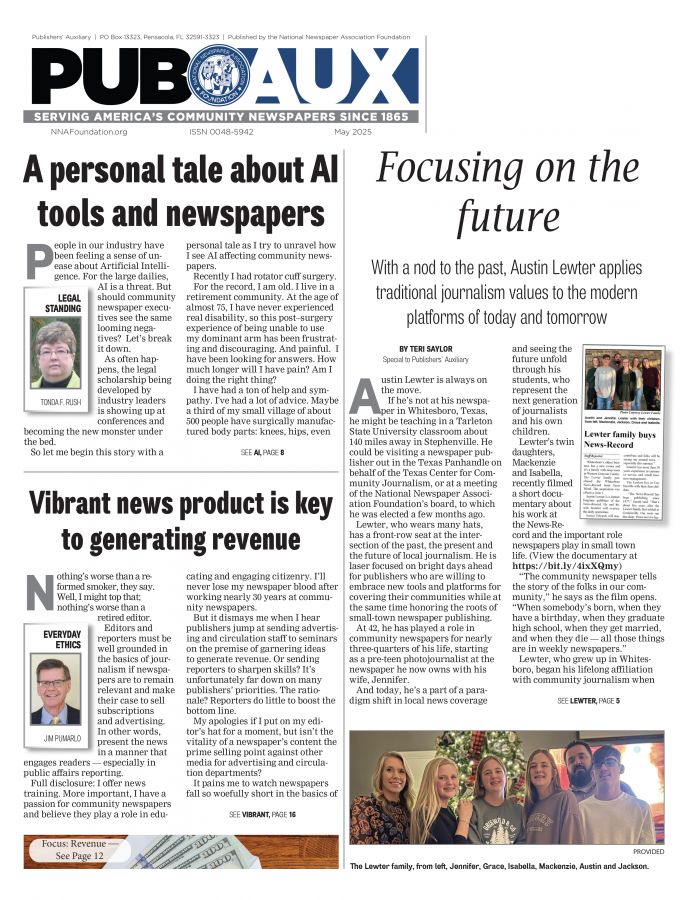Newspapers Unify their Communities: Going Local
Oct 1, 2013
R
ob Curley’s message was crystal clear: The Internet didn’t kill newspapers—it only killed their business model.
Curley, a leader in the Orange County Register’s subscriber-focused business model, was the keynote speaker during the National Newspaper Association’s 127th Annual Convention and Trade Show. As deputy editor of local news, Curley pushed for a huge expansion of newsroom personnel. When he first started at the company there were 181 people in the newsroom. Now there are more than 400. The company owns more than 20 community newspapers, and as part of Curley’s initiative, switched two of those papers to daily distribution and launched a new weekly, the Santa Ana (CA) Register.
What effect did this expansion have on the newspaper company? Readership and profits are increasing at an exponential rate.
Orange County is vast, encompassing 34 cities with different demographics and personalities, Curley said, and the newspaper company wanted to be “that one thing that unifies the whole thing.”
“The newspaper has to be the visionary,” he said, “and we can’t do that if we’re hobbling along.” The newspaper has to grow, which is why he started increasing newsroom personnel.
He looked at other high-growth companies, such as Starbucks, and sought to move the Orange County Register’s business model in the same way. Starbucks focuses on the customer, he noted. Just change the word customer to subscriber and you have the Register’s new business model.
He wanted to change the subscription price of the Register to $1 a day, and equated it to how Starbucks promotes its coffee and the whole coffee experience.
“When you buy a year-long subscription to the paper, it’s going to cost you $365,” he said. “But if I’m going to do that, I have to make the coffee taste really good.”
A newspaper’s roots have to be strong, he added, and “the roots to great journalism come from community journalism.”
Curley also looked at subscription-based businesses and noted that HBO has 15 million subscribers that pay for maybe four original programs each month, and a bunch of movie reruns.
“They can do this because the concept is so superior to what free TV is offering,” he said.
“The newspaper has to be so great that people would be willing to pay $30 a month and not even flinch,” Curley said. “That was our goal.”
It comes down to understanding what readers want to read, he explained, learning how readers consume stories.
To do that, the staff of the company looked at the key performance indicators of all the stories running on the paper’s website. Curley wanted to see which stories had the longest time spent on them by people who live in the community. From this he learned that there were 18 topics that were always read.
He put those stories into three major categories:
1. Does it serve our readers? This can mean all sorts of things, such as what happened at the City Council meeting, what happened with school hires, etc. “It has to be part of the narrative of our reader’s lives,” he said. It could also mean where do I get a good burger or where do I take a sick child at 3 a.m. “It means different things to different people.”
2. Can it save lives? “If we commit this act of journalism will it save readers’ lives,” he said. I can’t just be an important story that no one would read, Curley added, because it won’t save our readers. He asks his reporters: “If you were not writing this story, would you read it? … So no more writing boring stories that no one wants to read.”
During one story conference, he asked for ideas on a local, important story that needed to be written? Then he put one of his best writers on it. The reporter wrote a great 2,000-word story that fewer than 100 people read online, and the majority of those stopped reading after 24 seconds. He then had the story edited down to 500 words. After that, the story was the No. 1 read article on the site—with 4.5 minutes being the average time spent on the story. The headline noted that the article contained the top five things that would change the readers’ lives.
“Use math to improve how people read,” he said. Why use the inverted pyramid. If you’re going to put all the crappy stuff at the bottom of the story, why not leave it out entirely?
3. The serendipity stories. Newspapers have always been good at giving readers what they didn’t know they needed, Curley said. Readers love to be surprised. His staff looks at what’s going in the paper every day and asks what is the serendipity; what is the story that will delight our readers.
“We want the readership to always be our focus.”
People need to know that humanity is good, he noted. Stories about the good things going on in a community will entice more people to read the paper.
Stories are budgeted four weeks out to give the staff time to plan on how to cover them and what art or graphics or related information should go with each article.
Big ads versus small ads
When he noted that the Internet destroyed newspapers’ business model, Curley said news companies had been focusing on getting large full-page ads from major retailers, because the return on investment was more than the effort needed to sell smaller, local ads.
“Newspapers are as wonderful now as they have ever been,” he said, “and journalism is as important as it has ever been.”
What newspapers should be focusing on now, he added, are small, local ads.







